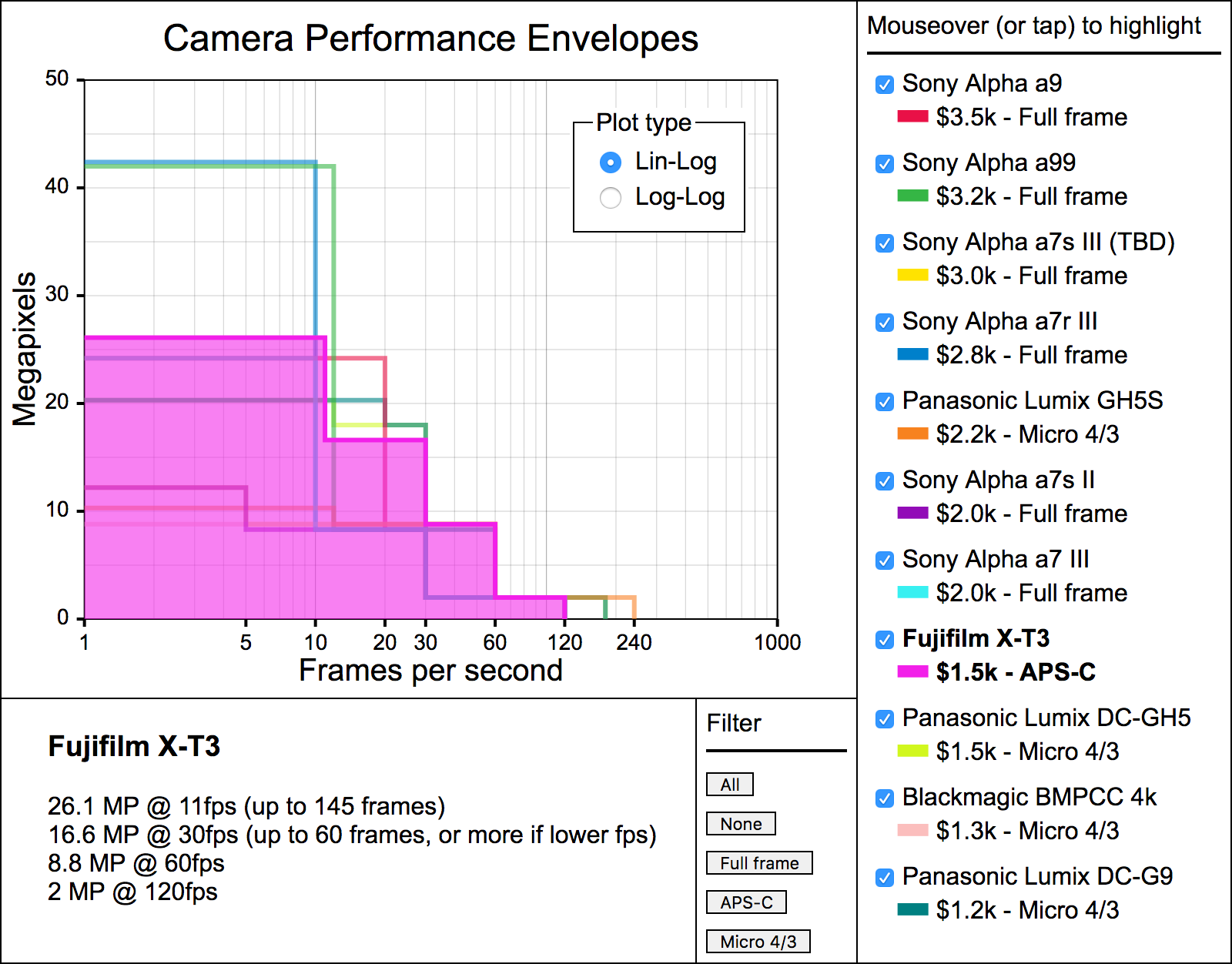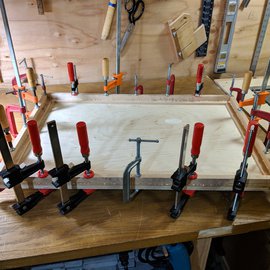Camera Comparisons
This interactive plot lays out the resolution and frame rate capabilities of leading digital cameras. You can mouseover or tap on any of the camera names to highlight it in the plot and view stats. You can also select and filter cameras from the plot with the buttons and checkboxes.
Background
My work deals with image sequences, whether they are are taken from the frames of a video or from continuous photo shooting (burst mode), or from interval shooting. The subjects I capture move at a variety of speeds. Some, like a hummingbird in flight, would benefit from 60 fps. And others, like floating leaves slowly drifting on a pond, can be captured as photos at one second intervals (1 fps).
So when looking at cameras, one question I had was: is there a camera that is well-rounded and can perform well across this whole range? Or would I be better off getting one photo-specific camera for slow moving subjects, and a separate video-specific camera for fast moving subjects? My price range was from $1-5k.
One criteria that I started with was the ability to record video at 4k/60fps. There's a handful of consumer-grade cameras I've found that can do so. But I also want to be able to capture subjects at 30fps, and ideally a camera that can do 4k at 60fps can do even higher resolution at 30fps, and then again even higher resolution at 10fps, and so on.
Apples to apples
For instance, 4k video is 4096 × 2160 = 8,847,360 pixels, or 8.8 megapixels. And perhaps a camera that can do 4k/60 can capture even more pixels at 30fps? Say, 5k-6k? or their burst-mode equivalents? And I'd like it to be able to take even higher resolution photos for interval shooting. Where this plot helps, is that it compares these settings uniformly, by treating everything in terms of megapixels.
In principal, given a certain data capture rate, you could trade off frame rate for resolution arbitrarily. For example, all else being equal, if you could set your camera to capture exposures of, say 1000x1000 pixels (1 megapixel) at 40 frames per second, then you could equally well set it to capture exposures of 2000x2000 pixels (4 megapixels) at 10 frames per second. Both involve the same amount of pixel-processing per second. In practice however, with consumer cameras you only have the preset resolution and frame rate settings to work with. You can't just dial these values up or down as you wish. (Though I believe there are certain classes of high-end cameras out there where you can do so.)
Few cameras try to do it all
As you look at the chart, notice how cameras tend to cluster together on one end of the spectrum or another. And notice how the cameras with full frame sensors push higher into the megapixel count, and the cameras with micro four thirds sensors push higher into the frame rate count. Also notice that 4k/60fps video is widely supported, yet >4k/30fps video is not as much. Perhaps it's not as in demand?
My camera of choice
After plotting the data like this, and flipping through the different curves, one camera stood out: the Fujifilm X-T3. It was a kind of a blind audition. I had initialy discounted this camera as being not the right choice for me, for more subjective reasons. (I hadn't an impression of Fujifilm as a leader in digital cameras, and this model looked like it was designed for retro aficionados – perhaps it merely offered style at the expense of performance). But, based on my reading of the data, the X-T3 is the most well-rounded of the bunch.
Sensor size
Regarding sensor size, it's a clear bonus that the X-T3 has the larger APS-C size sensor. Also, as far as I know it's the only consumer-class APS-C camera that can do 4k/60fps video. All the others that can do 4k/60fps use micro four thirds sensors. That is, until the Sony a7s III comes out, which will be the first full frame camera of this class able to do 4k/60fps. But one question I have is, will it be able to do greater than 4k at 30fps? I'm not so sure that it will. I suspect it's not as in demand.
Going from APS-C to a full frame system appears roughly double in price. That feels fair, especially considering that the sensor-area is roughly double too.
- Full frame sensor area: 36 x 24 = 864 mm2
- Fuji APS-C sensor area: 23.6 x 15.7 = 370 mm2
- Four thirds sensor area: 17.3 x 13 = 225 mm2
For a Sony Alpha body and a pair of good lenses covering a wide range of focal lengths, I estimate the price at about $6k. For the Fujifilm X-T3 body and a pair of good lenses covering a wide range of focal lengths, I estimate the price at about $3k. After considering the benefits of going full frame against the cost, and taking into account that I'm not really working in low-light conditions (where full frame is a clear win) and taking into account that the a7s III isn't yet released, and after reading a lot about Fujifilm's cameras and lenses, I confirmed my decision. For my current work I'll go with the X-T3.
In the context of my work
I produced my original batch of motion photos/videos using my trusty digital camera from 2009. It could capture 1280x720/60fps and 1920x1080/30fps. These resolutions are quite low for making still images and prints. It was a clear limiting factor, and one of the reasons I saw my initial work as essentially a proof of concept.
Now that the concept has been proven, it's time to invest in a better tool. I've done some careful research on currently available cameras. For my work, I'm interested in moving subjects of a variety of speeds, and I'd like to have a setup (with one camera or maybe two cameras) that can perform well across a wide spectrum of frame rates.
How this plot was conceived
When researching cameras it became apparent that I ought to consolidate all the resolution and frame rate specifications for the leading cameras, and so at first I did so in a spreadsheet. Then I decided I'd like to make a plot, and then I liked that plot so much, I decided to make a better plot, and make it interactive, and use it as an exercise for my javascript and data visualization programming skills.


